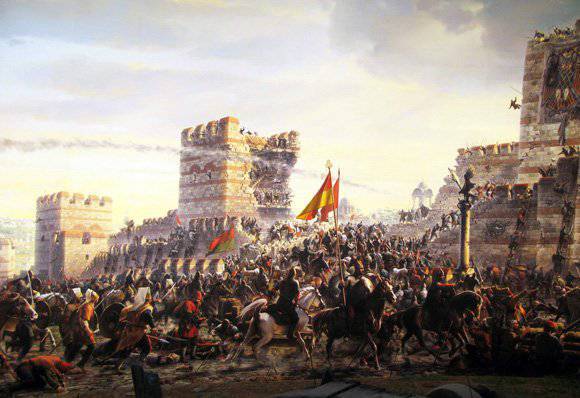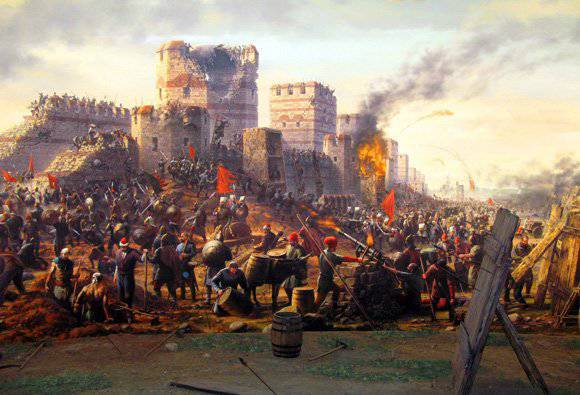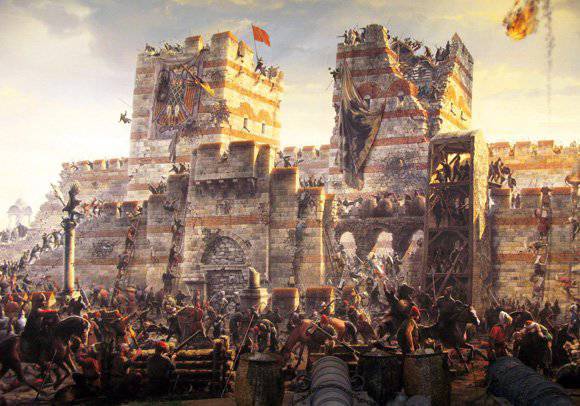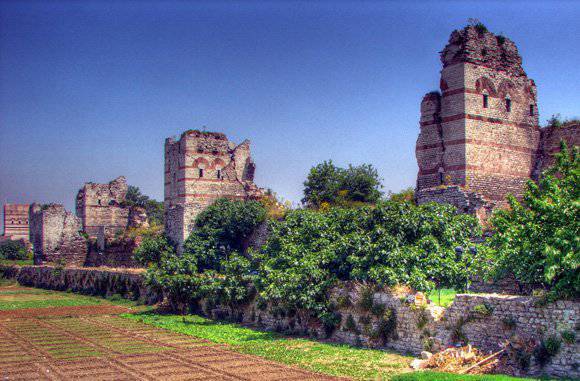The fall of Constantinople and the Byzantine Empire. Part of 3
These days, the last negotiations of citizens with the Sultan took place. Mehmed offered to surrender the city, saving the lives and property of the townspeople, or pay a huge tribute every year in 100 thousand gold byzantines. The Byzantines did not accept this offer. They did not intend to take the city, but they did not have such a huge amount of money. Constantine offered to give all possessions, except for the city. Sultan said that the citizens had a small choice: the surrender of the city and the departure from it, the death or the transfer of the population to Islam. At the negotiations ended.

The last fights, the fall of the city
25 May Sultan Mehmed convened a council. Vizier Khalil Pasha proposed to stop the siege. He was against this undertaking from the very beginning and believed that the course of the siege confirms his correctness. I recalled a number of failures. In his opinion, the fleet of Venice could soon approach, and then Genoa. Therefore, we must make peace on favorable terms and leave. Zaganos Pasha said he did not believe in the fears of the Grand Vizier. The European powers are divided, and the Venetian fleet, if it comes, will not be able to do anything. According to him, the attack must be strengthened, and not to leave. Many of the young commanders supported his position. Sultan ordered the preparation of the assault.
26 and 27 in May the city was heavily bombarded. At night the Greeks tried to restore the destroyed fortifications. 27 May Sultan drove around the troops and announced the imminent decisive assault. The following heralds proclaimed that the city would be given to the “fighters for the faith” to be plundered in full within three days. Mehmed promised a fair division of all mining. These speeches were met with shouts of joy. 28 May 1453, Monday, was declared a day of rest and repentance, so that Muslim warriors gained strength before the decisive battle. Tuesday announced the day of the assault.
At this time, the Sultan gathered his advisers and military leaders for a military meeting. It was decided to send troops wave after wave until the defenders jerked. Zaganos Pasha received the mission to land some of his forces on ships and land troops to attack the walls at the Golden Horn. The rest of his forces were to cross the pontoon bridge and attack the Blakhern quarter. To his right, a section of the wall to the Harisian Gates was attacked by Karadzha Pasha. Ishaq and Mahmoud received the task of attacking the walls of the gate of St.. Romana to the Sea of Marmara. The Sultan himself was going to strike in the area of the river Lykos.
In the city, the emperor invited all notable people and commanders. Constantine spoke of the need to be ready to die for his family, homeland, sovereign and faith. He recalled the exploits of their Greek and Roman ancestors. He thanked the Italians present and called on the defenders to stand up to the last. Then he walked around the room and asked for forgiveness from everyone. All followed his example, hugging and saying goodbye, as before death. In St. Sophia flocked all who were not on the walls, and the Orthodox, and unionists, and the Latins. They confessed, offered prayers and it was a real moment of unity of all Christians in the face of terrible danger.
In the evening of May 28, the Turkish camp was set in motion: the Ottomans were completing their final preparations, some were finishing up the ditches, others were moving closer to the cannon and wall battering and throwing machines. In the night from 28 to 29, there was a terrible noise caused by the roar of voices and various instruments, and the Turks rushed to the assault along the whole line of fortifications. The sentinels in the city raised the alarm, the churches sounded the alarm, all the men rushed to the walls. Women helped them, dragged water, stones, boards, logs. Old people and children gathered in churches.
Sultan somewhat changed the original plan and threw into the battle not his best forces, but bashi-bazouks. They were seekers of prey and adventures from various countries, including Christians - Hungarians, Germans, Slavs, Italians and even Greeks. The attack went all along the line of the walls, but the main blow was delivered in the valley of Lycos. The remaining directions were for the diversion of the Greek forces. The battle immediately became fierce. Bishibuzuki faced violent resistance. The soldiers of Giustiniani were better armed, trained, and got at their disposal almost all the muskets and food that were in the city. Konstantin arrived at the battlefield to cheer the soldiers on. After a nearly two-hour battle, the sultan recalled the bashi-bazouks. The Greeks began to restore the fortifications, but had little time. With the support of artillery, the second Turkish wave rushed into battle - regular troops from Anatolia. They were much better armed, organized, than bashibuzuki, besides among them were fanatics. But they, like bashibuzuki, suffered great losses - a huge number of people were concentrated in a narrow place, this allowed the defenders to hit almost every shot or throw a stone, a throwing spear.
The Greeks successfully repulsed the second assault, about an hour before dawn, and this wave began to choke. But at this time the core of the Basilica made a big hole in the fortifications. About three hundred Turks immediately rushed into the breach. The emperor and the warriors surrounded them, most of the bursting Turks were killed, some rejected for breach. Such a fierce rebuff brought the Turks into confusion, besides the troops were already tired. Anatolian units were relegated to their original positions. In other directions, assault attempts were repulsed. In the area of the Golden Horn, the Turks confined themselves to a demonstration, they did not dare to land.

The Sultan did not wait for the Greeks to close up the breach, and threw into the battle the third wave - the Janissaries. Sultan Mehmed brought them to the pit and stayed there, cheering on their favorites. The battle reached the highest point: selected Turkish troops fought with already tired warriors who fought for several hours in a row. A fierce battle took about an hour. It seemed that this wave defenders repulse. But then two incidents happened at once that dramatically changed the picture of the battle. Several Turks noticed the door (Kerkoport) between the wall of Theodosius and the Vlacherna district, through which the defenders made forays. Someone forgot to close it and a small detachment of the Turks penetrated the wall. Christians noticed this and rushed to close the door to cut off the enemy’s small advance guard. At the same time, in the area of Lykos, Justiniani Longo was shot and wounded by a nucleus fragment. Bleeding and experiencing severe pain, he asked his comrades to remove him from the battlefield. Emperor Constantine asked him to stay in order not to embarrass the defenders. Giustiniani insisted on being taken away. The bodyguards took him to the Genoese ships - after the fall of the city, he would break into the sea (Giustiniani would not recover from his wounds and die in June 1453 of the year). The Genoese soldiers without their commander were confused, panic began, someone felt that they had been abandoned and the battle was lost. The Genoese fled, leaving the Greeks and the Venetians. The Turks noticed a commotion among the enemies and one squad of janissaries was able to climb the crest of a broken barrier. The Greeks rushed at them and the Janissaries were almost all killed, but were able to hold out so much that others joined them. The Greeks tried to repel the onslaught, but were discarded. People ran to hide behind the inner wall. The emperor with several associates fought at the gate of the inner gate, the Turks did not recognize him and he died the death of the brave. Together with him, his cousin Theophilus Paleologus fell.
At the same time, the Turks poured into Kerkoport, the Genoese Bocciardi was too little to stop this flow. There was a shout: "The city is taken!" In the Kirkoport area, the Genoese fought for some time, then realizing that the matter was lost, they began to make their way to the ships. One of the brothers Bocciardi - Paolo died, the other two were able to get to the ship and moved to Peru. The Venetians of Minotto were encircled in the old imperial palace in Vlacherna. Many died, some were captured (some were later executed). Turkish ships in the Golden Horn received news of a breakthrough, landed troops and almost without resistance defeated the wall. Venetians rushed to their ships, the Greeks fled to their homes, trying to save the family. The crews of the two Cretan ships barricaded themselves in three towers. At the station south of Lykos, the soldiers were surrounded, most fell, trying to break through. L. Notaras, F. Contarini and D. Kantakuzin were captured. True, he was executed later, when Notaras refused to give the 14-year-old son to the sultan's harem, Mehmed loved young boys. In some places, the defenders themselves surrendered and opened the gates, in exchange for promises to keep their homes and families. Prince Orhan with his Turks and the Catalans fought to the last. I must say that the captured soldiers were few - about 500 Greek soldiers and mercenaries. The remaining defenders fell or escaped.
In the city, there was robbery and massacre. The Turkish sailors, fearing that the city would be plundered without them, threw the ships and fled into the city. This saved the lives of many citizens. The Genoese, led by Alvizo Diedo in Pere, cut off the straps that held the chain. The entrance from the gulf was open and several Venetian, Genoese and Byzantine ships fled, taking those they could. The Turks could not stop them. The last center of resistance was in three towers near the entrance to the Bay of the Golden Mountains. Cretan sailors stayed the longest, knocked them out failed. They gave up only when they were promised life and freedom. Turkish commanders kept their promise - they allowed the Cretans to dive aboard their ships and quietly leave.

Aftermath
- The soldiers were entitled to a three-day robbery, as they were promised. Turks and other subjects of the Sultan occupied the whole city. Initially, many people were killed, including women and children. Then people began to seize to sell. For example, in sv. Sophia killed all the old men and cripples, but captured young women, girls, boys, noble people.
During the robberies and pogroms, the mass of cultural values, including real relics, like the icon of Our Lady Odigitriya (The Guidebook), perished and disappeared. According to legend, she was performed by Luke himself. Soon, the selected parts of the Sultan put things in order, it was already a Turkish city and he did not want additional damage. To many notable Byzantine prisoners, the sultan showed mercy, even bought himself. But many Italians were waiting for a penalty.
- With the death of Constantine XI and Constantinople, the Byzantine Empire ceased to exist. Her lands became part of the Ottoman Empire. The sultan granted the rights of the self-governing community within the state to the townspeople, the community was headed by the Patriarch of Constantinople. He was responsible for her before the sultan. The Turkish sultan himself, began to consider himself the successor of the Byzantine emperor and took the title Kaiser-i Rum (Caesar of Rome).
Modern Turkey and the storming of Constantinople
The attitude of the modern Turkish public to the fact of the occupation of Byzantine territory and Constantinople is eloquently indicated by the opening of the 2009 panorama museum in Istanbul in 1453. The fall of Constantinople 29 May 1453 of the year is served as one of the most important and heroic events throughout stories Turkish state. For the Turks, the date of the fall of the capital of the Byzantine Empire symbolizes approximately the same as for the citizens of Russia - 9 May 1945. The fact that the decision to create a panorama was made in 2005 at the highest level, by Turkish Prime Minister Recep Erdogan, speaks about the importance of this museum and the event.
From a common sense point, it looks very interesting. The Turks are proud of the event during which the army of Mehmed II carried out the seizure and large-scale “sweep” of the capital of the ancient state. The townspeople were partly slaughtered, partly sold into slavery, partly forced to become subjects of the sultan, and driven into "self-governing communities" (ghettos). Constantinople was covered with blood, plundered, of sv. Sofia and a number of other temples are turned into mosques. Just a standard set of war crimes. And for the Turkish people - this is the greatest feat of the nation ...

Information